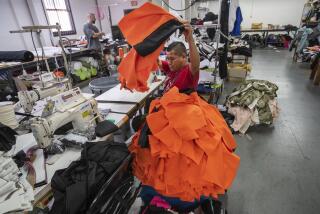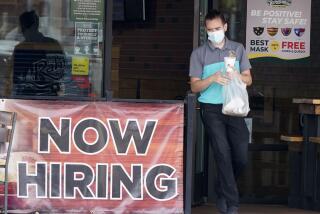Manufacturing Comeback Is Back on Endangered List
- Share via
The ailing U.S. manufacturing sector exhibited some signs it was clawing out of a 14-month slump before the Sept. 11 terrorist attacks, a key industry report showed Monday, but fallout from the assault could choke off recovery.
Separate reports indicated that construction spending fell sharply in August, while consumers spent only cautiously despite government tax rebates. This underscored the economy’s fragile state even before hijackers crashed commercial jetliners into the World Trade Center and the Pentagon.
The National Assn. of Purchasing Management said its September report did not provide a clear gauge of how the strikes affected the nation’s factories.
The industry group’s monthly index dipped only slightly in September to 47. August’s jump to a nine-month peak of 47.9 had raised hopes that the sector, locked in its worst slump since the 1990-1991 recession, was improving.
A reading under 50 indicates that manufacturing activity--nearly one-sixth of the overall economy--is declining. The NAPM index has now held below that level since August 2000, but has been steadily improving from January’s decade low of 41.2.
The report showed new orders and factory production both increased for a second straight month in September, albeit at a slower pace than in August, and that firms have made strides in trimming unsold inventories.
Leaner inventories mean that firms can meet new demand by ramping up production rather than having to sell goods stockpiled on warehouse shelves.
But analysts said the economic jolt from the attacks, which hammered consumer confidence and hurt sectors such as airlines, tourism and financial services, clouded the outlook for industry and the broader economy in months ahead.
“Before the attacks, the factory sector was in process of bottoming out,” said Jade Zelnik, senior economist at Greenwich Capital Markets.
“Of course now it’s a moot point, given that the consumer’s mood has turned gloomy. If, as is widely expected, consumer spending starts to contract, then that will reverberate back to the factory sector,” she said.
With stock markets slumping and unemployment rising even before the Sept. 11 attacks, a Commerce Department report suggested consumers were already in a cautious mode in August.
Despite receiving tax rebates, consumer spending grew by a modest 0.2% in August. Personal incomes were flat on the month, but tax refunds helped disposable after-tax income jump 1.9%, its biggest gain since December 1993.
“Spending growth was moderate, but when you put it against the boost to disposable incomes from the tax cuts, most of the tax cut was going into savings, not spending,” said John Ryding, senior economist at Bear Stearns.
Separately, the government said U.S. construction spending fell 1.1% in August--its fastest decline in more than a year--as construction of nonresidential buildings such as factories slumped.
The day’s economic reports only emphasized economists’ conviction that the Federal Reserve today will cut interest rates to rejuvenate an economy that ground to a near-halt in the second quarter.
More to Read
Inside the business of entertainment
The Wide Shot brings you news, analysis and insights on everything from streaming wars to production — and what it all means for the future.
You may occasionally receive promotional content from the Los Angeles Times.










